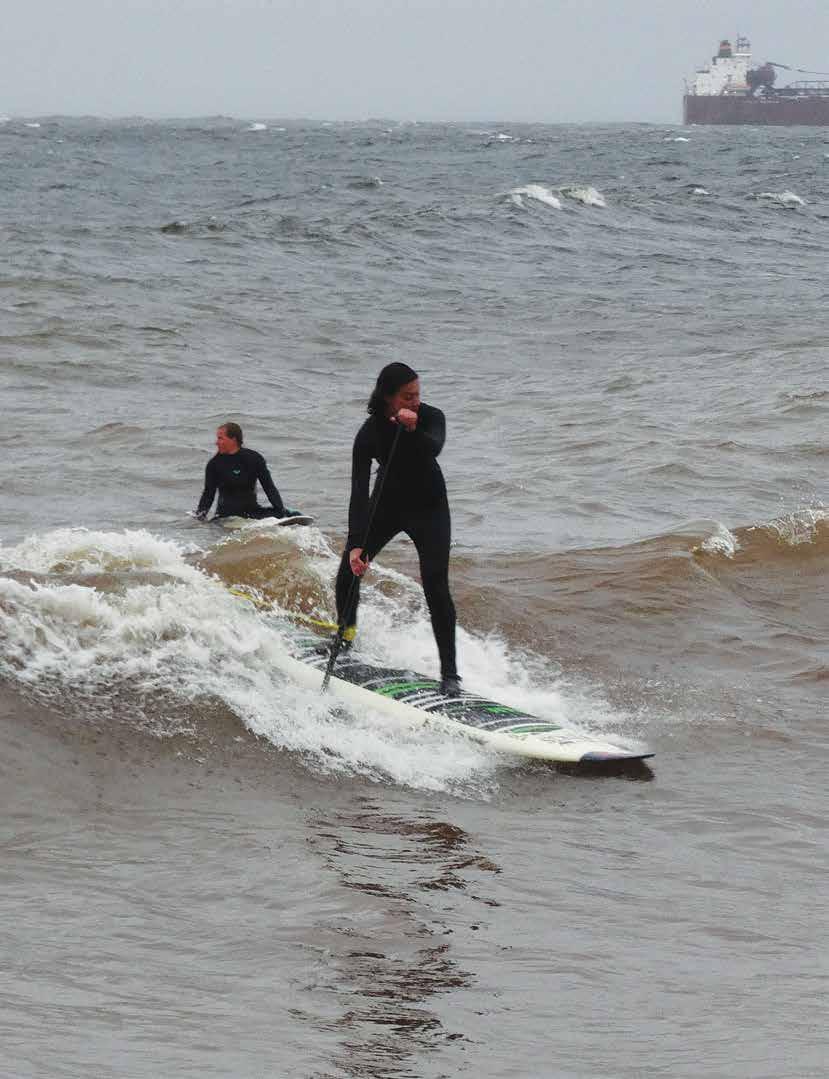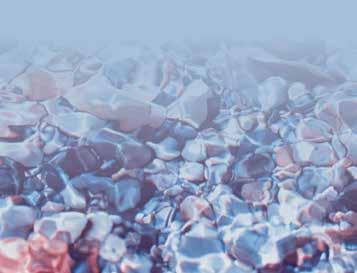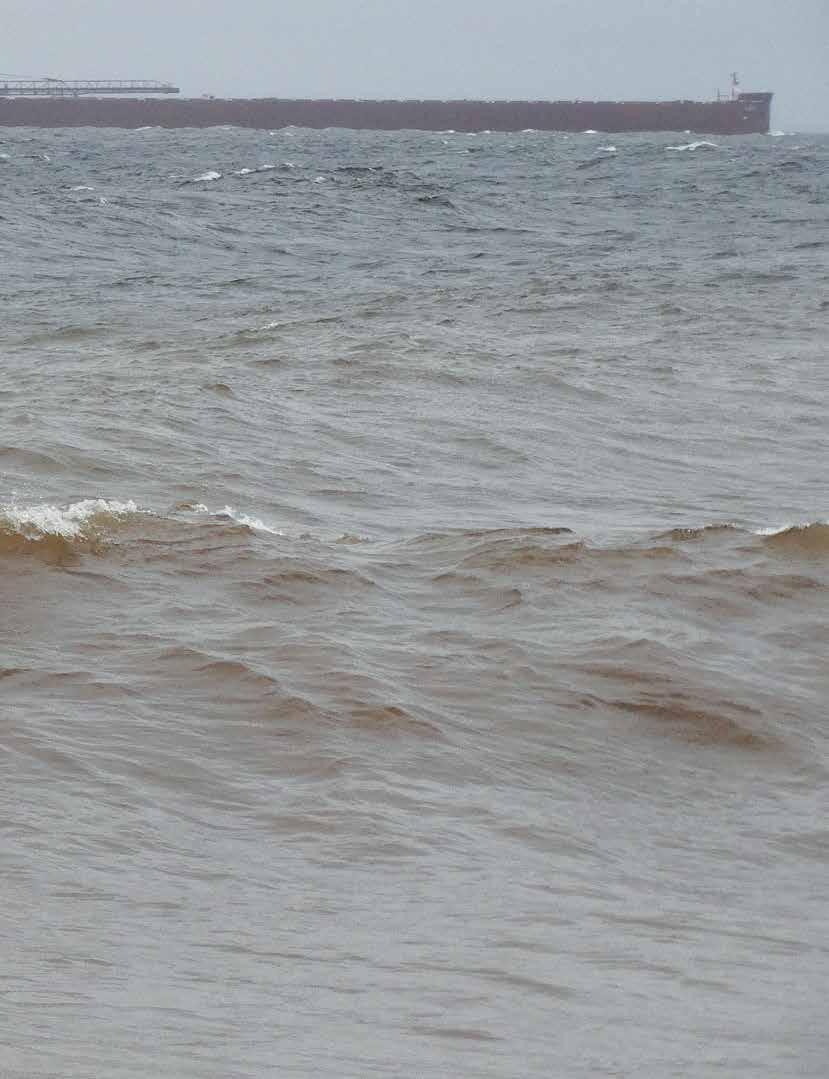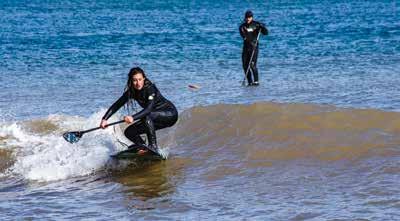
3 minute read
Surfing up north? You betcha!
Background: Jenny Schwietz surfs in Lake Superior with a ship in the background.
Inset: Jenny Schweitz, who has now been surfing for about six years, caught her first wave on accident while a student in UMD’s surf program.
By Abigail Blonigen
“Iremember my freshman year, I saw somebody with a surfboard in the dorms, and I was like alright that’s pretty cool, I’m going to follow up on that,” said Jenny Schwietz, who was then an undergraduate student at the University of Minnesota Duluth.
One would expect to see a surfboard floating around the dorms in Hawaii or southern California — a place with more sun, less snow and an ocean shoreline. As it turns out, the saltless sea of Lake Superior is in fact big enough to surf on.
Schwietz grew up in the Twin Cities area, just outside St. Paul. She moved to Duluth for college in 2013. She earned her undergraduate degree in biochemistry and is currently a master’s student at UMD studying biology.
After “following up” with the surfboard in the dorm,
Schwietz was able to connect with UMD’s surf club in spring 2014. The program is popular among students and generally sells out within one day. Schwietz was able to secure a spot, and actually became a surf and paddle instructor the following year.
In the surf program, students train in UMD’s pool, learning to paddle, control their board, and fall safely. When the weather conditions are favorable, students get to test their skills in Lake Superior.
“Your first time surfing, you get so tired, and you think it is the hardest thing in the world that you are doing,” said Schweitz, recalling her first time.
Schwietz remembers paddling out into the lake for what felt like forever. To catch a wave, surfers are supposed to paddle into the wave until they begin gilding, at which point they stand up. It is easier said than done, of course, and requires a great deal of practice.
Schwietz managed to catch a wave on accident.
“I completely accidentally caught a wave, so I was like, all right, I guess I’ll stand up now,” she said.
After that, she was hooked.
“That was kind of it for me. I caught that wave and now I haven’t stopped.”
Schwietz has since surfed in southern California, Florida and the Dominican Republic. Southern California is her go-to spot; she’s surfed there about eight times.
“When I go out there, people ask where we’re from because we talk funny,” she said. “They’re usually pretty blown away that we learned how to surf out here.”
Surfing in the ocean is different than surfing in the Great Lakes. The water in the ocean is warmer, the salt water makes surfers more buoyant and there is more time between waves — 10-12 seconds as opposed to Lake Superior’s six to seven.

Lake Superior is colder and windier, but Schwietz said the waves she has surfed in Minnesota and Wisconsin are comparable in size to the waves she has surfed in the ocean.

Northland surfers tend to be well versed in weather patterns to figure out where best to surf and when. There are a number of websites to help forecast the wind and waves in the area.
“As you become more experienced in this area, you can tell which wind directions make which spots on the lake work the best,” said Schwietz. “For me it’s part of the fun.”
While Stoney Point tends to be the most popular spot in Duluth, Schwietz has explored much of the north and south shores. Her favorite spots aside from Stoney Point are near the Lester River in Duluth; Flood Bay, north of Two Harbors; and along the Keweenaw Peninsula of Michigan.
Due to wind patterns, surfing conditions tend to be best in the area during the colder months. To stay warm in frigid Lake Superior, surfers wear wetsuits that cover everything but their faces, complete with mittens and boots.

“That keeps you pretty warm actually. You’d be surprised,” Schwietz said.
The suits allow some water to get in, which provides a layer of insulation as it is warmed by body heat. However, if one falls in just the right way, the impact can let in a friendly blast of ice cold water.
Though Schwietz is not a runner, she compares the experience of surfing to what she imagines a runner’s high feels like.
“When you catch your first wave or when you start getting higher in skill level and you’re riding these waves consistently, that feeling is unlike anything else,” she said.
While the unpredictable nature of surfing may be unsettling to some, it’s what Schwietz loves about the sport.
“I really like the nature of the environment, how uncontrolled the environment is,” she said. “That wave is coming whether you like it or not, whether you’re ready for it or not.”
For those bold enough to want to give freshwater surfing a try, Schwietz advises to get the right equipment and to know the spot in which you are going to surf. Surfing can be dangerous when folks are getting in the way or are attempting waves outside of their skill level. Schwietz recommends Park Point as a perfect beginner location.
Schweitz also recommends new surfers to push themselves past the point at which they want to give up.
“Most of the time you’re not actually exhausted — you just have to slow down and take a breath.” D










